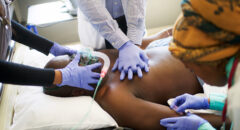
Heart disease and breast cancer are two of the most significant health threats facing women today. For Black women, these conditions often intersect in ways that amplify their risks. While they may seem unrelated, emerging research reveals a silent connection between heart and breast health, driven by overlapping risk factors, systemic disparities, and the unique challenges Black women face in accessing timely and effective care.
The Silent Connection Between Heart & Breast Health
Heart disease and breast cancer are often considered separate health issues, but they share significant links. These connections are particularly important for Black women, who are more likely to develop both conditions at younger ages and with more severe consequences.
Overlapping Risk Factors
Several factors contribute to both heart disease and breast cancer risk, including:
- Obesity: Excess weight is a major risk factor for both conditions. Black women have higher rates of obesity compared to other racial groups, increasing their susceptibility.
- Hypertension: High blood pressure, a hallmark of cardiovascular disease, has been associated with an elevated risk of breast cancer, particularly in postmenopausal women.
- Diabetes: This condition increases inflammation and hormone imbalances, which can contribute to both heart disease and breast cancer.
- Inflammation: Chronic inflammation is a common pathway in developing both conditions. It accelerates plaque buildup in arteries and can promote tumor growth.
The Role of Cancer Treatments
The treatments for breast cancer, including chemotherapy and radiation therapy, can also have cardiotoxic effects, increasing the risk of heart disease. For example:
- Chemotherapy Drugs: Anthracyclines and HER2-targeted therapies are effective against breast cancer but can damage heart cells.
- Radiation Therapy: Radiation to the chest area can expose the heart to harmful doses, leading to long-term cardiovascular complications.
For Black women, who are often diagnosed at more advanced stages of breast cancer, these treatments are administered at higher intensities, compounding their risk of developing heart disease.
Breast Cancer as a Cardiovascular Risk Marker
Studies suggest that women who survive breast cancer are more likely to die from heart disease than cancer itself. This is particularly relevant for Black women, who have lower survival rates due to late-stage diagnoses and limited access to follow-up care.
Understanding the interplay between heart and breast health is essential for developing strategies to reduce the dual burden of these conditions.
Why Black Women Face Greater Risks With Late-Stage Diagnoses
Disparities in Breast Cancer Outcomes
Black women are 40 percent more likely to die from breast cancer compared to white women despite having similar incidence rates. This disparity is largely due to late-stage diagnoses, which reduce treatment options and survival chances.
Contributing Factors:
- Limited Access to Screening: Black women are less likely to have regular access to mammograms, leading to delayed detection.
- Triple-Negative Breast Cancer: This aggressive subtype is more common in Black women and is harder to treat.
- Systemic Racism in Healthcare: Implicit biases and unequal access to care contribute to delays in diagnosis and treatment.
RELATED: 5 Ways to Lower Your Heart Disease and Breast Cancer Risk at the Same Time
The Overlap with Heart Disease
The health disparities that lead to late-stage breast cancer diagnoses also play a role in the higher prevalence of heart disease among Black women. For example:
- Socioeconomic Barriers: Limited access to healthy foods, safe exercise spaces, and regular healthcare contribute to both conditions.
- Chronic Stress: Stress from systemic racism and socioeconomic challenges increases inflammation and cortisol levels, which can elevate the risk for both diseases.
- Healthcare Distrust: Historical and ongoing mistreatment of Black patients creates mistrust in the healthcare system, leading to delays in seeking care.
A Vicious Cycle
Heart disease and breast cancer risks often form a vicious cycle for Black women. Preexisting heart conditions can complicate cancer treatment, while cancer treatments can exacerbate cardiovascular issues. Without integrated care, these overlapping risks are often overlooked, leaving Black women vulnerable to poor outcomes.
Breaking Barriers To Integrated Care
The Need for Holistic Approaches
To address the dual burden of heart disease and breast cancer, a more integrated approach to care is essential. This means looking at women’s health holistically, recognizing the connections between conditions, and addressing systemic barriers that disproportionately affect Black women.
Strategies for Integrated Care
1. Multidisciplinary Teams
Healthcare providers need to collaborate across specialties to ensure comprehensive care. For example:
- Cardio-Oncology Clinics: These specialized clinics bring together cardiologists and oncologists to manage the cardiovascular risks of cancer treatment.
- Patient Navigators: Trained navigators can help Black women access screenings, treatment, and follow-up care, reducing delays and improving outcomes.
2. Culturally Competent Care
Culturally competent care acknowledges the unique challenges Black women face and incorporates their cultural, social, and economic contexts into treatment plans. This includes:
- Addressing implicit biases in healthcare.
- Building trust through community engagement.
- Offering tailored health education materials.
3. Accessible Preventive Services
Preventive care is key to reducing the risks of both heart disease and breast cancer. Strategies include:
- Increasing access to free or low-cost mammograms.
- Providing hypertension screenings and management programs.
- Promoting lifestyle changes through community-based initiatives.
The Role of Research
More research is needed to understand the unique health challenges Black women face. This includes studies on:
- How social determinants of health influence disease outcomes.
- The impact of combined heart and cancer treatments on long-term health.
- Effective interventions to reduce health disparities.
Empowering Black Women Through Awareness
Education and awareness are critical to empowering Black women to take control of their health. This includes:
- Recognizing Symptoms Early: Teaching women to identify early signs of heart disease and breast cancer.
- Advocating for Comprehensive Care: Encouraging women to ask their healthcare providers about cardiovascular risks associated with cancer treatment.
- Building Support Networks: Connecting women with support groups and resources that address their unique needs.
Conclusion
The intersection of heart disease and breast cancer presents a significant health challenge for Black women, but it also offers an opportunity to rethink how we approach women’s health. We can improve outcomes and save lives by recognizing the connections between these conditions, addressing systemic disparities, and promoting integrated care.
Black women deserve equitable, comprehensive care that acknowledges their unique challenges. It’s time to bridge the gap between heart and breast health and ensure that no woman has to choose between fighting cancer and protecting her heart.








